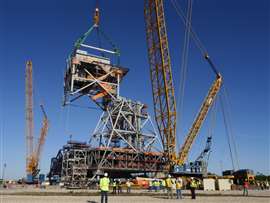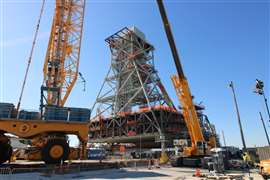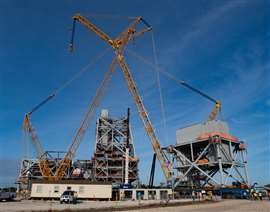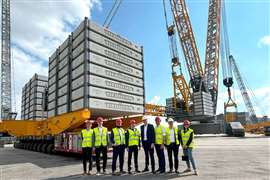Read this article in Français Deutsch Italiano Português Español
Images: Bechtel lifts section of new Kennedy Space Center launch tower into place
07 January 2025
 Mod 4 is lifted by a CC8800 Demag crane during Rig and Set at the Mobile Launcher 2 Parksite. (Image courtesy of Bechtel)
Mod 4 is lifted by a CC8800 Demag crane during Rig and Set at the Mobile Launcher 2 Parksite. (Image courtesy of Bechtel)
US-based construction contractor Bechtel has overseen the lifting into place of the first module for a new launch tower at the Kennedy Space Center, Florida.
The lifting and placing of Tower Module 4 of Mobile Launcher 2 was completed using the rig and set process.
Bechtel said it marked the start of a new phase of rapid vertical installation of the remaining tower modules, which will be stacked successively on top of one another in the coming months.
At their full height, the tower modules will be nearly 38 storeys tall.
 Mobile Launcher 2 pictured after crews successfully placed Mod 4 on top of the tower chair. (Image courtesy of Bechtel)
Mobile Launcher 2 pictured after crews successfully placed Mod 4 on top of the tower chair. (Image courtesy of Bechtel)
The Tower Module 4 weighs over 550,000 lbs (250.5 tonnes) and took over a month to assemble. The module was driven six miles by two self-propelled modular transporters from the ‘Mod Yard’ to the mobile launcher 2 parksite. Crews rigged it to a CC 8800 Demag heavy lift crane and raised the module over 150 feet (45.7 metres), securing the four corners to the tower chair. The rigging and lifting process took two days.
Bechtel said that taking a modular approach reduced risks to workers, allowing them to perform construction tasks at a lower elevation.
In addition to stabilizing the rocket and spacecraft for transport to the launchpad, the tower modules will carry and connect the complex array of umbilicals and systems to provide power, data, communication, propellants, fluids, gases, sound suppression, and imagery to the rocket and Orion spacecraft before launch. The modules are outfitted with much of this infrastructure, with the remainder to be installed when the full tower is assembled.
Mobile Launcher 2 will support NASA’s Artemis IV mission and beyond once the larger and more powerful Space Launch System (SLS) Block 1B rocket is used to begin delivering equipment to the Lunar Gateway. Reaching a height of 390 feet (118.9 metres), Mobile Launcher 2 will be taller and wider than Mobile Launcher 1. This launch platform will implement a new umbilical arm for NASA’s Exploration Upper Stage, which will be used during rocket transport and launch.
 Mod 4 pictured with the ML2 base and tower chair at the Parksite (Image courtesy of Bechtel)
Mod 4 pictured with the ML2 base and tower chair at the Parksite (Image courtesy of Bechtel)
STAY CONNECTED


Receive the information you need when you need it through our world-leading magazines, newsletters and daily briefings.
CONNECT WITH THE TEAM












